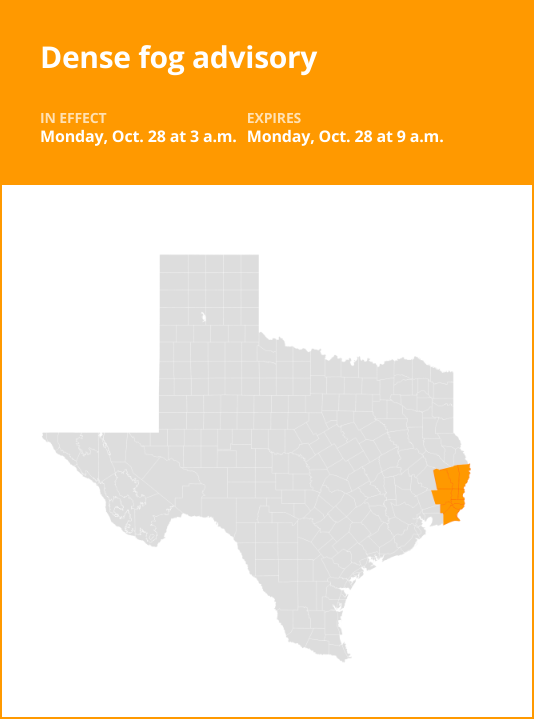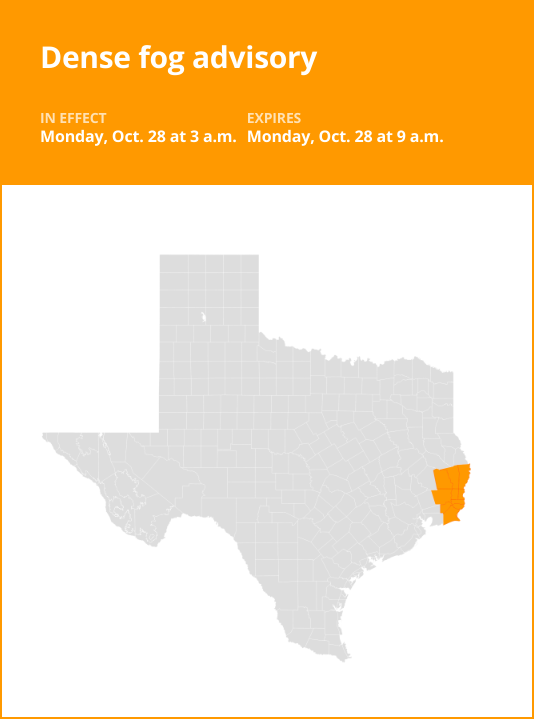Dense fog advisory affecting Southeast Texas Monday
Published 2:43 pm Sunday, October 27, 2024
On Sunday at 2:39 p.m. a dense fog advisory was issued by the National Weather Service valid for Monday between 3 a.m. and 9 a.m. The advisory is for Upper St. Martin, Lower St. Martin, West Cameron, East Cameron, Northern Calcasieu, Northern Jefferson Davis, Northern Acadia, Upper Vermilion, Upper Iberia, Upper St. Mary, Southern Calcasieu, Southern Jefferson Davis, Southern Acadia, Lower Vermilion, Lower Iberia, Lower St. Mary, Northern Jasper, Northern Newton, Southern Jasper and Southern Newton as well as Beauregard, Allen, Evangeline, St. Landry, Lafayette, Tyler, Hardin, Jefferson and Orange counties.
The NWS states, “Visibility less than one mile in dense fog.”
“Low visibility could make driving conditions hazardous,” adds the NWS. “If driving, slow down, use your headlights, and leave plenty of distance ahead of you.”

Navigating fog: Safety tips by the NWS
Trending
If a dense fog advisory is issued for your area, it means that widespread dense fog has developed and visibility often drops to just a quarter-mile or less. These conditions can make driving challenging, so exercise extreme caution on the road, and if possible, consider delaying your trip.
If driving in fog becomes unavoidable, remember these safety tips:
Moderate your speed:
Slow down and allocate extra time for your trip to reach your destination safely.
Visibility matters:
Ensure your vehicle is visible to others by using low-beam headlights, which automatically activate your taillights. Utilize fog lights if your vehicle is equipped with them.
Trending
Avoid high-beams:
Refrain from using high-beam headlights, as they create glare that impairs your visibility on the road.
Maintain safe gaps:
Keep a considerable following distance to account for sudden stops or shifts in traffic patterns.
Stay in your lane:
To ensure you are staying in the correct lane, use the road’s lane markings as a guide.
Visibility near zero:
In extremely dense fog where visibility is near zero, the best course of action is to first turn on your hazard lights, then simply pull into a safe location such as a parking lot of a local business, and stop.
No parking options:
If no designated parking area is available, pull your vehicle as far off the road as possible. Once stationary, deactivate all lights except the hazard flashers, engage the emergency brake, and release the brake pedal to ensure your tail lights remain unlit, minimizing the chance of other drivers colliding with your stationary vehicle.
By adhering to these NWS recommendations, you can navigate foggy conditions more safely, reducing the risk of accidents and ensuring your well-being.
Source: The National Weather Service






